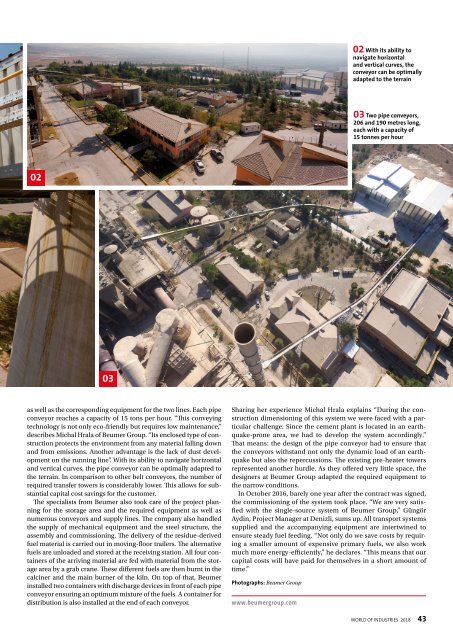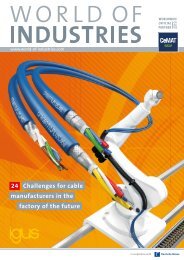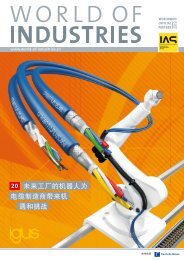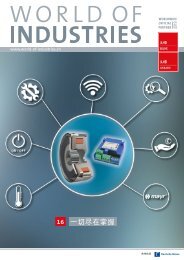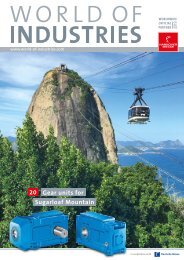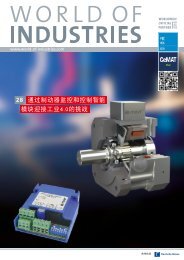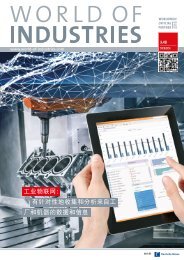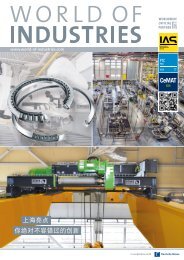WORLD OF INDUSTRIES 01/2018
WORLD OF INDUSTRIES 01/2018
WORLD OF INDUSTRIES 01/2018
You also want an ePaper? Increase the reach of your titles
YUMPU automatically turns print PDFs into web optimized ePapers that Google loves.
02 With its ability to<br />
navigate horizontal<br />
and vertical curves, the<br />
conveyor can be optimally<br />
adapted to the terrain<br />
03 Two pipe conveyors,<br />
206 and 190 metres long,<br />
each with a capacity of<br />
15 tonnes per hour<br />
02<br />
03<br />
as well as the corresponding equipment for the two lines. Each pipe<br />
conveyor reaches a capacity of 15 tons per hour. “This conveying<br />
technology is not only eco-friendly but requires low maintenance,”<br />
describes Michal Hrala of Beumer Group. “Its enclosed type of construction<br />
protects the environment from any material falling down<br />
and from emissions. Another advantage is the lack of dust development<br />
on the running line”. With its ability to navigate horizontal<br />
and vertical curves, the pipe conveyor can be optimally adapted to<br />
the terrain. In comparison to other belt conveyors, the number of<br />
required transfer towers is considerably lower. This allows for substantial<br />
capital cost savings for the customer.<br />
The specialists from Beumer also took care of the project planning<br />
for the storage area and the required equipment as well as<br />
numerous conveyors and supply lines. The company also handled<br />
the supply of mechanical equipment and the steel structure, the<br />
assembly and commissioning. The delivery of the residue-derived<br />
fuel material is carried out in moving-floor trailers. The alternative<br />
fuels are unloaded and stored at the receiving station. All four containers<br />
of the arriving material are fed with material from the storage<br />
area by a grab crane. These different fuels are then burnt in the<br />
calciner and the main burner of the kiln. On top of that, Beumer<br />
installed two containers with discharge devices in front of each pipe<br />
conveyor ensuring an optimum mixture of the fuels. A container for<br />
distribution is also installed at the end of each conveyor.<br />
Sharing her experience Michal Hrala explains “During the construction<br />
dimensioning of this system we were faced with a particular<br />
challenge. Since the cement plant is located in an earthquake-prone<br />
area, we had to develop the system accordingly.”<br />
That means: the design of the pipe conveyor had to ensure that<br />
the conveyors withstand not only the dynamic load of an earthquake<br />
but also the repercussions. The existing pre-heater towers<br />
represented another hurdle. As they offered very little space, the<br />
designers at Beumer Group adapted the required equipment to<br />
the narrow conditions.<br />
In October 2<strong>01</strong>6, barely one year after the contract was signed,<br />
the commissioning of the system took place. “We are very satisfied<br />
with the single-source system of Beumer Group,” Güngör<br />
Aydin, Project Manager at Denizli, sums up. All transport systems<br />
supplied and the accompanying equipment are intertwined to<br />
ensure steady fuel feeding. “Not only do we save costs by requiring<br />
a smaller amount of expensive primary fuels, we also work<br />
much more energy-efficiently,” he declares. “This means that our<br />
capital costs will have paid for themselves in a short amount of<br />
time.”<br />
Photographs: Beumer Group<br />
www.beumergroup.com<br />
<strong>WORLD</strong> <strong>OF</strong> <strong>INDUSTRIES</strong> 2<strong>01</strong>8 43


